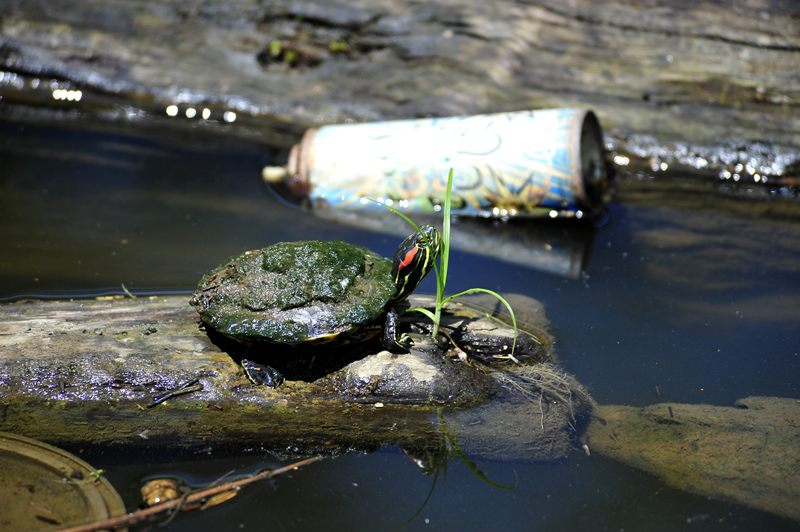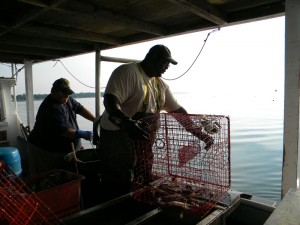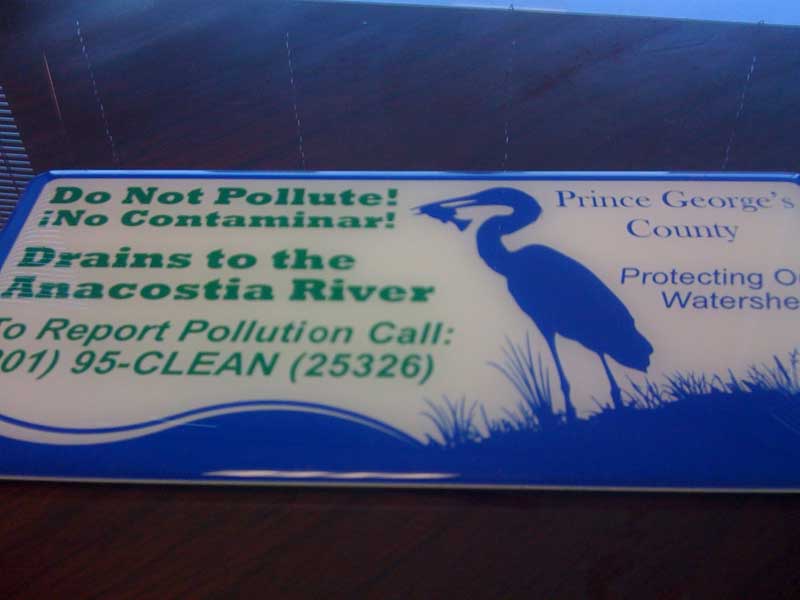27
The Great Chesapeake Toilet Bowl
Is your favorite swimming spot dirtier than toilet water?
That’s what News21 set out to learn this summer by taking water samples from popular beaches and recreation sites along the Chesapeake Bay — and comparing them to water from an unflushed toilet.
Read our story–and see the test results–here.
7
Upper Marlboro Farm a Model of Best Practices
UPPER MARLBORO, Md. – The manager of Clagett Farm strides across a large pasture, expertly avoiding cow dung. As if accustomed to the drill, roughly 45 hungry cows follow closely behind.
“You see this section?” Michael Heller asks, pointing to the area where the cows had grazed. “See how much they grazed it down? It’s almost like a lawn mower came in here and mowed it down.”
But the grass won’t get eaten down to its roots – which would create bare spots and foster soil erosion – thanks to a process Heller employs called rotational grazing. The farm, owned and operated by the nonprofit Chesapeake Bay Foundation, serves as a model of how best management practices such as rotational grazing can be used to improve water quality.
It’s one of many voluntary practices recommended for farmers by the state to minimize harmful nutrient runoff into rivers and streams feeding the Chesapeake Bay.
With traditional grazing, cows are allowed to graze freely through in an open pasture. The cows will eat their favorite types of grasses down to the roots, avoiding the grass they do not like. To grow the grass back, farmers often apply fertilizers and herbicides.
Heller instead sections off the pasture on Clagett Farm, forcing the cows to eat all types of grass. The cows are then moved to a new section when the grass has been eaten to about 2 inches high.
And by only using the cows’ natural waste to fertilize each section, Heller explained, Clagett Farm has eliminated the use of fertilizers.
In general, agricultural runoff has been identified by the Environmental Protection Agency as one of the leading contributors of pollution in the bay.
Though the state encourages farmers, through subsidies and grants, to use best management practices, the law does not require them.
“The only requirement that a farmer has in a regulatory context is that every farmer who has over 10 acres and/or generates more than $25,000 in revenue has to have a certified nutrient management plan,” said Dr. Russell B. Brinsfield, director of the Wye Research and Education Center at the University of Maryland’s College of Agriculture and Natural Resources said.
The plan, certified by the Maryland Department of Agriculture, has been required since 1998. It sets recommendations for the amount of fertilizer a farmer can apply to a crop and when, Brinsfield said.
In addition to raising 65 cows, Clagett Farm grows 56 types of fruits and vegetables. The farm plants cover crops, such as rye and clover, on unused land during the off seasons, Heller said. Cover crops soak up excess nutrients that remain in the soil after seasonal plants, like strawberries and lettuce, have been harvested.
During the spring, the cover crops are tilled into the soil, eliminating the need for synthetic fertilizers, he said.
“It’s one of the most effective best management practices that we have,” Brinsfield said.
To further reduce runoff, Clagett Farm does not plant crops on hills, Heller said. The steep land, susceptible to soil erosion, is covered with permanent vegetation–grass and clover.
On this morning, Gail Taylor and five other Clagett Farm employees are kneeling, pulling weeds out of soil, rather than spraying. “On conventional farms they would just go out in a big tractor with herbicide and spray the heck out of all the fields and try to kill everything with chemicals,” Taylor said.
The costs associated with using best management practices, such as planting cover crops or switching to rotational grazing, can be a financial burden on farmers since their profit margin isn’t great, Brinsfield said.
However, the Maryland Agricultural Water Quality Cost-Share Program provides farmers with up to 87.5 percent of the cost to install conservation methods, said Julie Oberg, a spokeswoman for the Maryland Department of Agriculture.
And the federal farm bill was amended in 2008 to include funding specifically for these types of conservation practices. There are currently 30 current best management practices eligible for these grants, Oberg said.
Heller is proud of the work he does.
“The wonderful thing about all this is it’s using ecological principals in nature itself,” said Heller. “It works for the environment because it protects the bay.”
–by Rabiah Burks
30
Migratory Birds, Fish Could Feel Impact of Gulf Spill
OCEAN CITY, Md.– It is extremely unlikely that oil from the British Petroleum spill in the Gulf of Mexico will make its way into Maryland’s waters, but the spill could affect some of the region’s migratory birds and fish.
That was the consensus shared Tuesday by officials at Maryland Gov. Martin O’Malley’s roundtable discussion on the local effects and lessons learned from the spill.
Complex currents should keep the oil out of Maryland, but if anything from the Gulf does make its way this far north, it will be in the form of tar balls, or “hard, crusted” remnants” of oil, said Dr. Donald Boesch, president of the University of Maryland Center for Environmental Science.
“This is a wake-up call to us all,” said Boesch, who is a member of a commission that President Obama appointed to study and prevent future oil spills. While he said that Maryland’s waters would not likely fall victim to large, catastrophic blowouts like the one in the Gulf, pipelines and barges that transport oil could leak into the state’s waterways.
There is a lot at stake financially and environmentally in Maryland’s waters.
“We have many migratory shorebirds who will be queuing up and heading south for the winter in the Gulf area,” said John Griffin, secretary of the Maryland Department of Natural Resources. They include terns, skimmers, egrets and blue herons, he said.
Griffin also said that migratory fish such as marlin might be affected.
The governor’s team agreed that the catastrophic spill in the Gulf is a warning for officials and environmental experts.
“We are benefitting and learning from the lessons … in the Gulf,” said Shari Wilson, Maryland secretary of the Environment.
O’Malley discussed in detail with his team the emergency preparedness plans in place in Maryland. They rely on cooperation between the government and private companies to effectively use booms and vacuums to collect and treat water in the event of a spill.
–by Allison Frick
29
Fixing Anacostia Pollution Won’t Be Quick

A young Eastern painted turtle, covered in algae, basks on some driftwood while a discarded spray paint can floats nearby in the Anacostia River. (News21 photo by Jason Lenhart)
WASHINGTON – Renovations to the Blue Plains Wastewater Treatment Plant — needed to help shore up an antiquated sewer system in the nation’s capital — are a year ahead of schedule, with completion expected in 2014, D.C. Mayor Adrian Fenty says.
But even with the updates, controlling raw sewage runoff into the Anacostia River during heavy rains may remain an issue until at least 2018, say the District’s water and sewer authority and environmental advocates.
The long-standing problem: There isn’t enough space in combined sewage and stormwater pipes to effectively transport untreated runoff to the Blue Plains plant.
“When those pipes reach capacity, overflow valves flip over,” says Brent Bolin, director of advocacy for the Anacostia Watershed Society. “Essentially, raw sewage is discharged into the Anacostia River.”
Urban development in the Anacostia watershed has exacerbated the problem, he says. “As D.C. gets more and more built out, there’s more and more impervious surface and more and more runoff.”
The long-term solution, Bolin says, is to dig an eight-mile long tunnel that will capture and store excess storm water until it can be processed at Blue Plains. The Metrorail-sized tube will run from near RFK Memorial Stadium to Blue Plains.
“We applaud that they’re addressing the problem,” Bolin says. “But it’s a big engineering fix. It’s going to be a process to get through it.”
Currently, when overflows occur, thousands of gallons of polluted stormwater flood the river, exacerbating poor conditions of a river already deemed unsafe for swimming or fishing. (See map of overflow points.)
The overflows occur as many as 80 times a year, D.C. Water officials say. Their frequency is estimated using a model based on the amount of rainfall in a given year.
The renovation and tunnel fixes could reduce the number of combined sewer overflows to two a year, D.C. Water officials say. Reaching zero would make the cost of the project “magnitudes higher” than the current $2.5 billion price tag, according to analyses by D.C. Water and the Environmental Protection Agency.
The move to stifle sewage overflow events has been going on for more than 50 years, but the history of the sewer system goes back more than a century. In the late 1800s, Washington’s combined sewer system was considered to represent the best engineering standards available.
Fenty acknowledged after a meeting this month with the governors of Maryland and Virginia and environmental leaders that oversight could be better. “In the history of our city, our great nation’s capital, we haven’t always protected the rivers,” he said.
D.C. Water’s wide-ranging, $2.5 billion program includes constructing runoff tunnels to alleviate pressure on the Anacostia and Potomac rivers and Rock Creek.
“Right now, the grid is overwhelmed,” Bolin says. “There are two things you can do: You can give an outlet to the grid, or you can prevent the inputs.”
Source controls such as increased street sweeping, adding catch basins, and promoting low-impact development and green roofs could help alleviate the stress on the combined sewer, Bolin says.
–by Justin Karp
25
A Crabber’s Life: Days Are Consumed by the Water
SHADY SIDE, Md. – Capt. Bob Evans has the same routine six days a week, each and every week, during the warm months. He sets out on his 40-foot boat around 6:30 a.m. and, a few minutes after leaving the dock, is already pulling up his underwater lines.
Six hours later, after checking about 400 pots, he returns to the dock and makes the short drive to his store, where he unloads the bushels from his truck.
“I was raised on the water,” recalls Evans, 57. “I just couldn’t stay away from it. I started out as a kid just fishing and crabbing, and I absolutely loved it.”
For the past 40 years, he has been crabbing for a living. “I don’t know how to do anything else,” he says.
His crab pots are scattered in the bay and in nearby rivers in Shady Side. “Captain Bob,” as he likes to be called, has two men who work with him on his boat, while his two daughters run his seafood store in Churchton, Md.
“It’s a family business, and we like it. We’re proud of it,” he says.
Watermen must make enough in the summer season to last them for the year. “We don’t get a pay check every week,” Evans says.
“When you do good, you have to save your money for the tough times.”
This season has been good so far for Evans’ business. He caught more than $1,600 worth of crabs just on that day.
But he says that is not always the case.
“You’ll never get rich doing this,” Evans says. “But it’s a good honest living –and we’re proud of what we do.”
–by Alex Moe
25
All Signs Point to the Anacostia
Signs like the one above, which dot storm drains throughout the portion of Prince George’s County that lies in the Anacostia River watershed, are part of the county’s efforts to curtail pollution and dumping.
Samuel Moki, associate director of the Environmental Services Division of the Prince George’s County Department of Environmental Resources, says simple steps such as installing these street signs go a long way toward educating the public on how they can help to restore the Anacostia.
Moki says the billion-dollar, multi-agency and multi-state Anacostia restoration effort is cleaning up what has been one of the most polluted and neglected watersheds in the United States.
–by Justin Karp
25
Experts: Gulf Oil Shouldn’t Threaten Md.
WASHINGTON – Seafood coming from the Gulf of Mexico region is “absolutely safe” and Maryland is “very, very unlikely” to see any oil from the British Petroleum spill, scientists told Maryland’s congressional delegation Thursday.
Sen. Barbara Mikulski (D-Md.), who chaired the briefing, told representatives from the Food and Drug Administration and the National Oceanic and Atmospheric Administration that she has received e-mails from Marylanders asking if they should cancel plans to visit area beaches or avoid eating seafood.
“With 20 percent of our seafood coming from the Gulf, one of our questions was: Is the seafood safe, and how will we know it will continue to be safe (from oil and chemical dispersants)?” Mikulski said. “Marylanders are wondering: Is this going to come up to our beaches? And is it going to come up the bay,” wreaking havoc on seafood and the environment?
Joshua Sharfstein, principal deputy commissioner for FDA, outlined how the agency is working to close contaminated areas to fishing and test fish and water before reopening them.
Eric Schwaab, assistant administrator for fisheries at NOAA, told the delegation that multiple agencies are working together to monitor the seafood coming out of the Gulf region and ensure it is safe.
Steve Murawski, NOAA director of scientific programs for the oil spill, said the currents are working in such a way that water from the Yucatan Peninsula area is going straight over to Florida, and the water near the spill is staying in that region. Usually, that water would be part of a loop current and get pulled southeast, where it could join the Gulf Stream and be swept up the East Coast.
But even if the water from the area near the April 22 oil spill is pulled into the loop current, it is “very, very unlikely that any liquid oil is going to make it this far north,” Murawski said.
Sen. Ben Cardin (D-Md.) said he knows the likelihood of oil from the spill making it to Maryland is remote, but he is concerned about the potential impact on wildlife. For example, he said, what may happen to Orioles when they fly south?
He didn’t get an answer.
Cardin also said he wants to make sure there is sufficient baseline environmental data now, so any future impact on this region could be assessed.
Mikulski and Cardin repeatedly asked about the potential effect of chemical dispersants.
“It deeply troubles me that these additional risks are now there,” Cardin said. “We don’t have a body of evidence on these dispersants” at this level.
He raised his voice and challenged Sharfstein, who argued that the chemicals in the dispersants are relatively common and are unlikely to have any toxic effects.
“It’s unprecedented,” Cardin said of the amounts used.
Sharfstein agreed that the situation is
unprecedented, but stressed that “what we do know (about the chemicals) is reassuring.”
Mikulski told the expert panel she and her fellow lawmakers “don’t doubt science,” but also recall the damage wrought by Hurricane Isabel, which swept up the East Coast in September 2003.
“We went to bed and we thought we were safe, and then we woke up and we found out we weren’t,” she said. “What was once infrequent and unlikely is now coming with regularity and tremendous consequence.”
After the briefing, Mikulski said she wants to learn more about the dispersants. She chairs an appropriations subcommittee that funds NOAA, and the group will host a July 15 hearing on them.
–by Jennifer Hlad
24
Chesapeake Dead Zone: Nation’s Third Largest
GLOUCESTER POINT, Va. — The Chesapeake Bay has the third largest “dead zone” or oxygen-starved area of water in the United States, typically spreading across 1,500 square kilometers of water, said Robert Diaz, a top scientist at the Virginia Institute of Marine Science.
In a very bad year, that number can shoot up to 2,000 square kilometers, or more than one-tenth of the entire estuary. Only the Gulf of Mexico and Lake Erie have larger dead zones.
Early predictions for this year by researchers at the University of Maryland Center for Environmental Science suggest the Chesapeake’s water quality could be better this summer. The UMCES scientists this week said they were forecasting one of the smaller dead zones in Chesapeake for the last 25 years.
They credited positive climate conditions as well as effective agricultural policies, but cautioned that their predictions could change as the summer progresses. Last year, the bay’s dead zone turned out to be bigger than forecast.
Diaz, in an interview Thursday, said he was waiting to see predictions from Donald Scavia, a researcher formerly of NOAA and now with the University of Michigan.
Predicting and measuring the Chesapeake’s dead zone has become an annual ritual because oxygen levels in its waters are considered a critical factor in analyzing the health of the estuary’s ecosystem.
Dead zones are caused by an overly heavy influx of nutrients like nitrogen and phosphorous from farm run-off, storm run-off and sediment flushing into the Bay from its river tributaries. The nutrients feed algae, which proliferate, die and then suck oxygen out of the water. Sediment further clogs the system.
Typically the Chesapeake’s dead zone covers roughly 15 to 20 percent of the bay, Diaz said. In a bad year, it can reach close to 2,000 square kilometers, and in a good year can shrink to 800-900 square kilometers.
The culprit is a “combination of land modification, agriculture, expanded population,” Diaz said. “Until we bring these runoff nutrients under control, nothing will happen.” The result of a dead zone is typically a muddy bottom where little beyond microbes and bacteria survive. Fish and seafood flee the area and congregate in the shallows.
Reducing agricultural nutrient run-off is a central element of eliminating the dead zone. “These things can be reversed with proper management,” Diaz said.
The public has largely been unaware of the Chesapeake’s dead zones simply because they are not visible. “You could be boating over a dead zone and not even know it, because it’s a phenomena that affects bottom waters, and not surface water,” Diaz explained.
But underneath the surface, fish, crabs and shrimp are evacuating large areas where they can no longer breathe and escaping to shallower waters. Sometimes the dead zones will shift to these waters as well, forcing the panicking fish to physically jump out of the waters – and sometimes into fishermens’ nets, an event ironically known as a “jubilee.”
–by Sharon Behn
24
Suburbanites Disconnected from Impact on Anacostia
WASHINGTON – The stream that runs behind the houses in Salil Kharkar’s Silver Spring neighborhood impacts the quality of the water in the Anacostia River, just downstream.
The problem is that others on the block might not know that.
“There are strong communities that want to protect their own watersheds,” says Kharkar, a wastewater treatment engineer for D.C. Water.
But, he says, they’re unaware their watershed is the Anacostia’s.
The Anacostia River watershed extends for 176 square miles across Montgomery and Prince George’s counties and Washington, D.C. — but only 38 square miles lie in the city itself. The rest encompasses dozens of streams, creeks and branches that extend north into suburban Maryland.
A substantial amount of the multi-million dollar Anacostia cleanup focuses on the 6.8 miles of river that flow through the nation’s capital. But Kharkar and others believe that real progress can’t be made until residents of the watershed living outside the city are educated about the impact of their actions.
“People outside the environmental community are really buying into a future where the Anacostia River is an amenity to the community,” says Brent Bolin, director of advocacy for the Anacostia Watershed Society. But, he says, to get there, more awareness is needed.
While trash buildup and stormwater runoff from streets and parking lots remain the two biggest pollution problems plaguing the river, sediment and nitrogen runoff from upstream sources, such as Sligo Creek, the Northeast and Northwest branches and other Maryland streams, flow unchecked into the Anacostia.
“It’s sort of just letting people know that simple things they can do really make a difference,” Bolin says. “People don’t want to do the wrong thing. They just don’t know what the right thing is.”
He says steps as simple as properly disposing of grass clippings and other yard waste instead of dumping them into streams and creeks can go a long way toward reducing the amount of toxic nutrients, like nitrogen and phosphorous, that plague the watershed.
Carlton Ray, who administers a long-term control plan for D.C. Water, says that environmental stewardship is not at the top of the minds of many watershed residents.
“People are struggling to put macaroni and cheese on the table and are busy rushing their kids to soccer practice,” he says. “It doesn’t leave much time for them to ask, ‘What’s this thing about the watershed?’ ”
The long-term control plan is the utility’s effort to significantly reduce the amount of untreated sewage overflow entering the Anacostia from point sources during heavy rains. But both he and Kharkar agree this overflow is only part of the pollution problem in the Anacostia and that additional cleanup efforts from outside the city’s boundaries are vital.
“It’s something that needs to continue to be nurtured,” Ray says.
Ken Yetman, division chief for watershed assessment for the Maryland Department of Natural Resources, says it doesn’t help that the District sees a disproportionate benefit from a clean river.
“There [are] billions of dollars being invested in new real estate down there along the Anacostia,” he says. “A healthier river will increase property value and will be a greater asset to the District.”
But ultimately, Yetman said, if suburbanites take care of their local streams, “it benefits those downstream. … The cumulative effect is that they care about the [Anacostia] river.”
–by Justin Karp
18
Experts Question Spill Preparedness in Chesapeake
As Congress hears testimony about the handling of the Gulf of Mexico spill, scientists and environmentalists question how prepared the government is to respond if a ship or barge were to leak oil into the Chesapeake Bay.
Experts say a quick-fire response is needed to stop oil from spreading in the shallow bay and reaching the shores.
“There is no functioning [emergency response] system on the Bay in the terms of what we call operational,” said William C. Boicourt, an expert in physical oceanographic processes at the University of Maryland Center for Environmental Science at Horn Point. He said the center has been working on an early warning system for wind and oil patterns, but such a system is at least two years away.
 “We don’t know of any detailed plans and response scenarios that are in place that have been practiced that are ready to go at a moment’s notice,” said William C. Baker, president of the Chesapeake Bay Foundation. “Clearly the states and the Coast Guard ought to do more planning.”
“We don’t know of any detailed plans and response scenarios that are in place that have been practiced that are ready to go at a moment’s notice,” said William C. Baker, president of the Chesapeake Bay Foundation. “Clearly the states and the Coast Guard ought to do more planning.”
Coast Guard Lt. Cmdr. Michael J. DaPonte said there are area contingency plans – collective efforts by federal, state and local agencies and industry representatives — to respond to water-related disasters on the bay.
But primary responsibility for cleaning any oil spill is the party responsible for the spill and the contractors it hires to do that work, DaPonte said.
–by Sharon Behn
This is an excerpt from a longer story; read full story from Behn in The Baltimore Sun.













